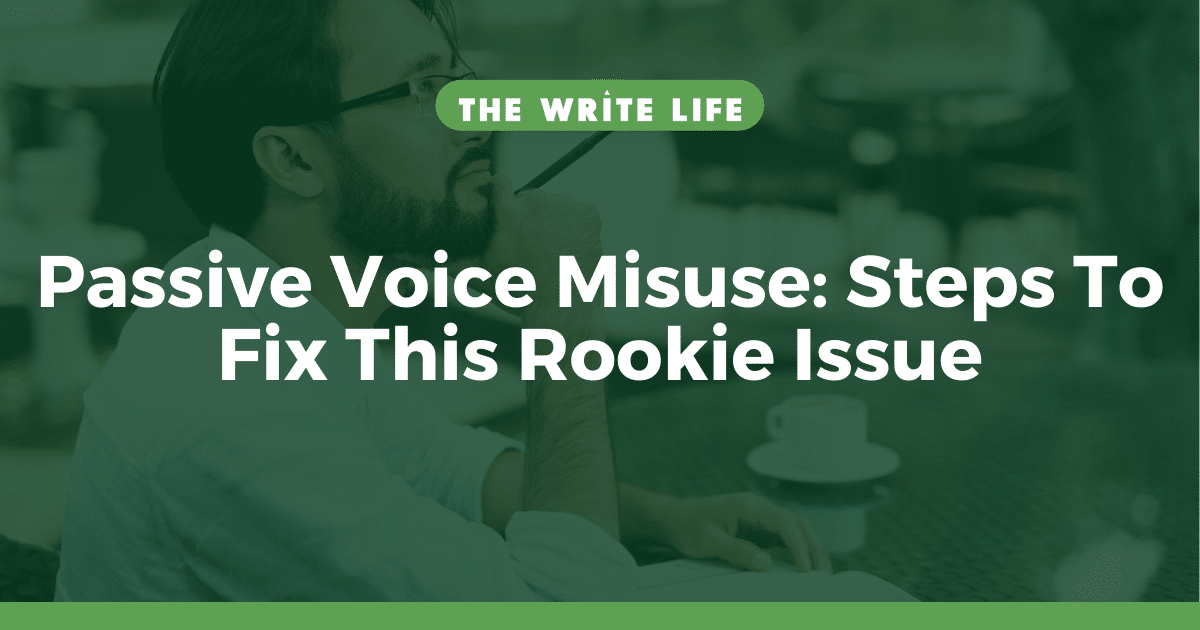If you’ve ever wondered what exactly qualifies as passive voice misuse you’ve come to the right place. Passive voice is an issue many new writers face. In fact, I didn’t know there was a “right way” to write until I was in college.
As a new writer, I thought great writing came down to the idea and the adjectives used to describe that idea. Point-of-view, voice, and tense were not major factors in my writing. Thankfully, once I began training in creative writing I quickly learned that I had a lot to study.
Passive voice misuse can set writers apart as novices or as experts who know how to wield writing rules with power. In this article, I define what passive voice misuse is, why it’s a no-no for new writers, and give four steps to fix passive voice misuse. Let’s get right into it!
Defining Passive Voice Misuse
While there is a time and place for this type of voice, passive voice misuse occurs when the subject should be performing the action.
Passive voice is simply when the subject of a sentence is acted on by the verb. Can you spot the use of passive voice in the previous sentence? You can make a sentence active by focusing on the subject as the one doing the action.
Passive: Passive voice is simply when the subject of a sentence is acted on by the verb.
Active: Passive voice is simply when the verb acts on the subject of a sentence.
In this active sentence, the verb is doing the action rather than the subject being acted upon. Many writers unconsciously use passive voice throughout their stories.
Why Passive Voice Is A No-No
The reason writers frown on passive voice is due to its unnecessary wordiness and lack of clarity. For newer writers, writing to just “get the story down” is perfectly acceptable. However, passive voice easily creeps in. Several issues can result:
- Protagonists feel reactive
- Confusion overrides clarity
- The writing lacks strength
It’s easy to write passively. It takes forethought to write in an active voice. So how do we fix this issue?
4 Steps To Fix Your Voice
One of the best ways to combat passive voice is to simply change your mindset in writing. If the mindset shift doesn’t work, there are some concrete steps you can take to further help. Let’s start with a mindset shift.
#1 – Move Action Forward With Purpose
At the core of writing lies an advancement of the plot. Consider the classic example of the hero’s journey: The protagonist sets off on a journey (literal or figurative) with an endpoint, or goal, in mind.
Whether it’s Frodo Baggins taking literal steps toward Mordor or Peter Rabbit hopping out of the garden and toward home just in time, these beloved characters feature a proactive mindset.
Personalize this mindset by focusing on the end of your story and proactively, rather than reactively, writing toward it.
Simple lines such as the following take on an entirely new meaning. For instance:
Example 1: Professional figure skating was her dream. The Olympics was a real possibility if she put in the work.
Example 2: She dreamed of professional figure skating, and if she put in the work, she could make it to the Olympics.
In the first example the reader passively takes in information. In the second, there is a sense of urgency. The protagonist is the one proactively dreaming.
#2 – Create An Active Protagonist
Your mindset also plays a role in how you describe your protagonist. Look through the following list and ask yourself how your protagonist would act or speak in the following situations:
- Planning a beach day but waking up to rain
- Responding to a breakup
- Getting rear-ended
- Pursuing their dream job
- Spotting a lost child
In the first three examples, outside circumstances impact the protagonist: Rain, being broken up with, and someone hitting their car. The last two feature the protagonist as proactive, or with the possibility of being proactive. How you write them is imperative:
- “It’s raining. I’ll go study at a coffee shop” Or, “It’s raining. I’ll have to stay in today.”
- “He broke up with me. I’ll cancel my plans.” Or, “He broke up with me. I’ll go home and process.”
- “That child looks lost. I wonder if his parents are around.” Or, “That child looks lost. I’ll go see if I can help.”
Same situation, similar responses, but one features a passive protagonist and the other a proactive one.
#3 – Cut Being Verbs
If the mindset shift isn’t quite doing it for you, try this concrete step: In point number two, look at the subtle difference in how I could write the opening sentence. In the sentence I used, I excluded being verbs. In the second example, I include being verbs.
Sentence 1: Your mindset also plays a role in how you describe your protagonist.
Sentence 2: Your mindset can also be influenced by how you describe your protagonist.
In the first sentence, the subject (mindset) leads the sentence actively (plays a role). In the second one, the subject is acted on by the verb.
In the same way, if your protagonist must complete a task, how can you shift the focus from their response to circumstances to them impacting circumstances? Frodo makes the active choice to take the ring to Mordor, even though he appears to be the least equipped out of the nine.
Imagine Tolkien writing The Lord of the Rings passively. Instead of the iconic line, “I will take the ring. I will take the ring to Mordor!” We could read, “The ring will be carried by me. The ring will be carried by me to Mordor.” This is the difference between writing actively and passively.
#4 – Try Present Tense
If you’re willing to take action steps even further, I’ve found present tense as a shortcut to learning the power of active voice. In fact, I wrote an entire manuscript in present tense rather than past tense because I felt so stuck in my habit of passive voice misuse.
Past tense: I was going home when I was followed by a black car.
Present tense: On my way home, I notice a black car following me.
For some reason, this shift dramatically helped me.
Caveat: Know The Rules So You Know When To Break Them
Now that we discussed several cons to passive voice misuse and how to combat it, it’s crucial to remember that there is a time and place to break writing rules.
Passive tense is not always, forevermore, and with no excuses, a no. For new writers, studying writing tips and how to write actively will aid their learning curve. However, writing passively is not always bad.
Learning how to write in an active voice helps you avoid passive voice misuse while also teaching you when you can use it.
Think of a painter: They know the brushes and what they are intended for, but sometimes they may choose a different brush, one that isn’t intended for a specific style, to help present their painting in a more nuanced way.
The same is true for tense. Learn the rules, and then enjoy (occasionally) breaking them!



